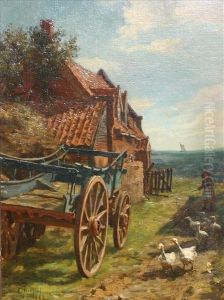Edwin Nichol Paintings
Edwin Nichol was a British painter known for his pastoral landscapes and animal scenes, which captured the bucolic charm of the British countryside. Born in 1855, Nichol's artistic journey began in an era when the British art scene was still heavily influenced by the Romantic movement, with a growing interest in naturalism and the depiction of rural life.
Nichol's work often focused on the accurate representation of animals, particularly cattle and sheep, which he rendered with a high degree of detail and sensitivity to their form and texture. His landscapes, while serving as a backdrop to these pastoral scenes, were composed with an eye for the harmonious interplay of light and shadow, and they evoked a sense of serenity and timelessness.
Throughout his career, Nichol exhibited his work widely, including at prestigious institutions such as the Royal Academy in London. His paintings resonated with Victorian audiences who were increasingly nostalgic for the vanishing rural landscapes of Britain amidst the rapid industrialization and urbanization of the period.
Nichol's approach to art was characterized by a dedication to realism and an avoidance of the stylistic flourishes that characterized some of the more avant-garde movements of his time. Instead, he focused on mastering traditional techniques and capturing the subtleties of the natural world. This dedication to realism earned him a respectable following and the patronage of collectors who appreciated his meticulous attention to detail and his ability to evoke the essence of rural British life.
Edwin Nichol passed away in 1939, leaving behind a legacy of work that continues to be appreciated for its quiet celebration of the countryside and its inhabitants. His paintings are a testament to the enduring appeal of pastoral art and provide a window into the rural landscapes of 19th-century Britain.
